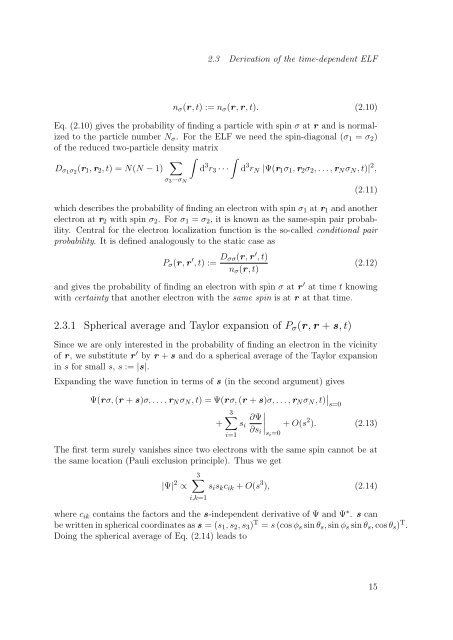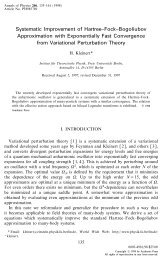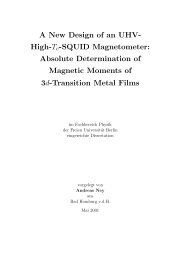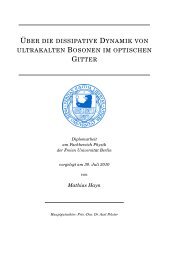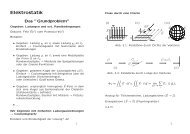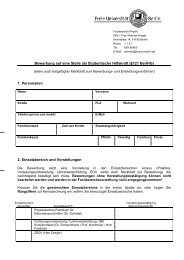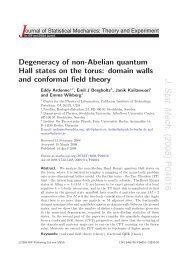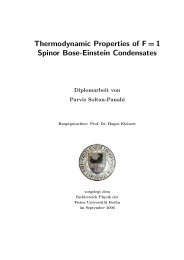Time-Dependent Electron Localization Function - Fachbereich ...
Time-Dependent Electron Localization Function - Fachbereich ...
Time-Dependent Electron Localization Function - Fachbereich ...
Create successful ePaper yourself
Turn your PDF publications into a flip-book with our unique Google optimized e-Paper software.
2.3 Derivation of the time-dependent ELF<br />
n σ (r, t) := n σ (r, r, t). (2.10)<br />
Eq. (2.10) gives the probability of finding a particle with spin σ at r and is normalized<br />
to the particle number N σ . For the ELF we need the spin-diagonal (σ 1 = σ 2 )<br />
of the reduced two-particle density matrix<br />
D σ1 σ 2<br />
(r 1 , r 2 , t) = N(N − 1) ∑ ∫ ∫<br />
d 3 r 3 · · · d 3 r N |Ψ(r 1 σ 1 , r 2 σ 2 , . . . , r N σ N , t)| 2 ,<br />
σ 3···σ N<br />
(2.11)<br />
which describes the probability of finding an electron with spin σ 1 at r 1 and another<br />
electron at r 2 with spin σ 2 . For σ 1 = σ 2 , it is known as the same-spin pair probability.<br />
Central for the electron localization function is the so-called conditional pair<br />
probability. It is defined analogously to the static case as<br />
P σ (r, r ′ , t) := D σσ(r, r ′ , t)<br />
n σ (r, t)<br />
(2.12)<br />
and gives the probability of finding an electron with spin σ at r ′ at time t knowing<br />
with certainty that another electron with the same spin is at r at that time.<br />
2.3.1 Spherical average and Taylor expansion of P σ (r, r + s, t)<br />
Since we are only interested in the probability of finding an electron in the vicinity<br />
of r, we substitute r ′ by r + s and do a spherical average of the Taylor expansion<br />
in s for small s, s := |s|.<br />
Expanding the wave function in terms of s (in the second argument) gives<br />
Ψ(rσ, (r + s)σ, . . . , r N σ N , t) = Ψ(rσ, (r + s)σ, . . . , r N σ N , t) ∣ s=0<br />
∣ 3∑ ∂Ψ ∣∣∣si<br />
+ s i + O(s 2 ). (2.13)<br />
∂s i =0<br />
The first term surely vanishes since two electrons with the same spin cannot be at<br />
the same location (Pauli exclusion principle). Thus we get<br />
|Ψ| 2 ∝<br />
3∑<br />
i,k=1<br />
i=1<br />
s i s k c ik + O(s 3 ), (2.14)<br />
where c ik contains the factors and the s-independent derivative of Ψ and Ψ ∗ . s can<br />
be written in spherical coordinates as s = (s 1 , s 2 , s 3 ) T = s (cos φ s sin θ s , sin φ s sin θ s , cos θ s ) T .<br />
Doing the spherical average of Eq. (2.14) leads to<br />
15


